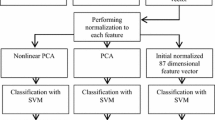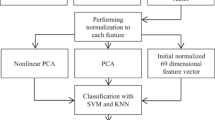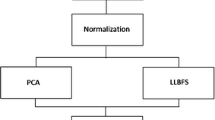Abstract
In this study, we wanted to discriminate between three groups of patients. Each group contains nine voice recordings collected from nine patients. The three groups are: Patients who suffer From Multiple system atrophy, patients who suffer from Parkinson’s disease and patients who suffer from other neurological disorders. We extracted from each voice sample from 1 to 20 cepstral coefficients of the MFCC, PLP and RASTA-PLP. We used for classification Support Vector Machines with its different kernels. The results were very encouraging and they varied between 92.59 and 100% of accuracy.
Similar content being viewed by others
References
Baker, K. K., et al. (1998). Thyroarytenoid muscle activity associated with hypophonia in Parkinson disease and aging. Neurology, 51(6), 1592–1598.
Benba, A., Jilbab, A., & Hammouch, A. (2014a). Voice analysis for detecting persons with Parkinson’s disease using MFCC and VQ. In The 2014 international conference on circuits, systems and signal processing (ICCSSP’14), September 23–25, 2014, Saint Petersburg, Russia.
Benba, A., Jilbab, A., & Hammouch, A. (2014b). Hybridization of best acoustic cues for detecting persons with Parkinson’s disease. In The second world conference on complex systems (WCCS14), November 10–12, 2014, Agadir, Morocco.
Benba, A., Jilbab, A., & Hammouch, A. (2014c). Voice analysis for detecting persons with Parkinson’s disease using PLP and VQ. Journal of Theoretical and Applied Information Technology (JATIT), 70(3), 443–450.
Benba, A., Jilbab, A., & Hammouch, A. (2014d). Voiceprint analysis using Perceptual Linear Prediction and Support Vector Machines for detecting persons with Parkinson’s disease. In The 3rd international conference on health science and biomedical systems (HSBS ‘14), November 22–24, 2014, Florence, Italy.
Benba, A., Jilbab, A., & Hammouch, A. (2015a). Detecting patients with Parkinson’s disease using PLP and VQ. In The 7th international conference on information technology (ICIT 2015), Mai 12–15, Amman, Jordan.
Benba, A., Jilbab, A., & Hammouch, A. (2015b) Detecting patients with Parkinson’s disease using Mel frequency cepstral coefficients and support vector machines. International Journal on Electrical Engineering and Informatics (IJEEI), 7(3), 297–307.
Benba, A., Jilbab, A., & Hammouch, A. (2016a). Voice analysis for detecting patients with Parkinson’s disease using the hybridization of the best acoustic features. International Journal on Electrical Engineering and Informatics (IJEEI), 8(1), 108–116.
Benba, A., Jilbab, A., & Hammouch, A. (2016b). Analysis of multiple types of voice recordings in cepstral domain using MFCC for discriminating between patients with Parkinson’s disease and healthy people. International Journal of Speech Technology, 19(3), 449–456.
Benba, A., Jilbab, A., & Hammouch, A. (2016c). Discriminating between patients with Parkinson’s and Neurological diseases using cepstral analysis. In IEEE transactions on neural systems and rehabilitation engineering (Vol. 24, No. 10, pp. 1100–1108). doi:10.1109/TNSRE.2016.2533582.
Benba, A., Jilbab, A., & Hammouch, A. (2016d). Voice assessments for detecting patients with Parkinson’s diseases using PCA and NPCA. International Journal of Speech Technology, 19(4), 743–75412.
Benba, A., Jilbab, A., Hammouch, A., & Sandabad, S. (2015c). Voiceprints analysis using MFCC and SVM for detecting patients with Parkinson’s disease. In 2015 international conference on electrical and information technologies (ICEIT). IEEE.
Benba, A., Jilbab, A., Hammouch, A., & Sandabad, S. (2016e). Using RASTA-PLP for discriminating between different neurological diseases. In The 2nd international conference on electrical and information technology (ICEIT 2016), May 04–07, 2016, Tangier, Morocco.
De Lau, L. M. L., & Breteler, M. M. B. (2016). Epidemiology of Parkinson’s disease. Lancet Neurology, 5, 525–535.
Gentil, M. (1990). Acoustic characteristics of speech in Friedreich’s disease. Folia Phoniatrica et Logopaedica, 42(3), 125–134.
Hansen, J. H. L., Gavidia-Ceballos, L., & Kaiser, J. F. (1998). A nonlinear operator-based speech feature analysis method with application to vocal fold pathology assessment. IEEE Transactions on Biomedical Engineering, 45(3), 300–313.
Hermansky, H. (1990). Perceptual linear predictive (PLP) analysis of speech. The Journal of the Acoustical Society of America, 87(4), 1738–1752.
Hermansky, H., et al. (1992). RASTA-PLP speech analysis technique. In icassp. IEEE.
Ho, A. K., et al. (1999). Speech impairment in a large sample of patients with Parkinson’s disease. Behavioural Neurology, 11(3), 131–137.
Huse, D. M., et al. (2005). Burden of illness in Parkinson’s disease. Movement Disorders, 20(11), 1449–1454.
Jellinger, K. A. (2015). Pathogenesis of multiple system atrophy-recent developments. International Journal of Neurology and Neurotherapy, 2, 022.
Lasierra, N., et al. (2012). Lessons learned after a three-year store and forward teledermatology experience using internet: Strengths and limitations. International Journal of Medical Informatics, 81(5), 332–343.
Little, M. A., et al. (2009). Suitability of dysphonia measurements for telemonitoring of Parkinson’s disease. IEEE Transactions on Biomedical Engineering, 56(4), 1015–1022.
Logemann, J. A., et al. (1978). Frequency and cooccurrence of vocal tract dysfunctions in the speech of a large sample of Parkinson patients. Journal of Speech and Hearing Disorders, 43(1), 47–57.
O’Sullivan, S. B., & Schmitz, T. J. (2007). Parkinson disease. In Physical Rehabilitation, pp. 856–894.
Perez, K. S., et al. (1996). The Parkinson larynx: tremor and videostroboscopic findings. Journal of Voice, 10(4), 354–361.
Qiu, F., et al. (2015). Comparative study of diagnostic significance of urethral sphincter electromyography and external anal sphincter electromyography in patients with multiple system atrophy. Journal of Neurology & Neurophysiology, 6(285), 2.
Rahn, D. A. III, et al. (2007). Phonatory impairment in Parkinson’s disease: Evidence from nonlinear dynamic analysis and perturbation analysis. Journal of Voice, 21(1), 64–71.
Sakar, B. E., et al. (2013). Collection and analysis of a Parkinson speech dataset with multiple types of sound recordings. IEEE Journal of Biomedical and Health Informatics, 17(4), 828–834.
Sapir, S., et al. (2007). Effects of intensive voice treatment (the Lee Silverman Voice Treatment [LSVT]) on vowel articulation in dysarthric individuals with idiopathic Parkinson disease: acoustic and perceptual findings. Journal of Speech, Language, and Hearing Research, 50(4), 899–912.
Stelzig, Y., et al. (1999). Laryngeal manifestations in patients with Parkinson disease. Laryngo-Rhino-Otologie, 78(10), 544–551.
Teston, B. (2001). L’évaluation objective des dysfonctionnements de la voix et de la parole; 2e partie: les dysphonies. Travaux Interdisciplinaires du Laboratoire Parole et Langage d’Aix-en-Provence (TIPA) 20, 169–232.
Van Den Eeden, S. K., et al. (2003). Incidence of Parkinson’s disease: variation by age, gender, and race/ethnicity. American Journal of Epidemiology, 157(11), 1015–1022.
Young, S., Evermann, G., Hain, T., Kershaw, D., Liu, X., Moore, G., et al. (2006). The HTK Book (for HTK Version 3.4). Copyright, 2001–2006. Cambridge University Engineering Department.
Funding
The authors have no financial relationship with the organization.
Author information
Authors and Affiliations
Corresponding author
Ethics declarations
Conflict of interest
All authors declares that they has no conflict of interest.
Ethical Approval
All procedures followed were in accordance with the ethical standards of the responsible committee on human experimentation (institutional and national) and with the Helsinki Declaration of 1975, as revised in 2008 (5).
Rights and permissions
About this article
Cite this article
Benba, A., Jilbab, A. & Hammouch, A. Detecting multiple system atrophy, Parkinson and other neurological disorders using voice analysis. Int J Speech Technol 20, 281–288 (2017). https://doi.org/10.1007/s10772-017-9404-6
Received:
Accepted:
Published:
Issue Date:
DOI: https://doi.org/10.1007/s10772-017-9404-6




